[revised June 2019]
Every function defined on $[-1,1]$, so long as it is a little bit smooth (Lipschitz continuity is enough), has an absolutely and uniformly convergent Chebyshev series:
$$ f(x) = a_0 + a_1 T_1(x) + a_2 T_2(x) + \cdots . $$
The same holds on an interval $[a,b]$ with appropriately scaled and shifted Chebyshev polynomials.
For many functions you can compute these coefficients with the command chebcoeffs. For example, here we compute the Chebyshev coefficients of a cubic polynomial:
x = chebfun('x');
format long
disp('Cheb coeffs of 99x^2 + x^3:')
p = 99*x^2 + x^3;
a = chebcoeffs(p)
Cheb coeffs of 99x^2 + x^3: a = 49.500000000000000 0.750000000000000 49.500000000000000 0.250000000000000
Similarly, here are the Chebyshev coefficients down to level $10^{-15}$ of $\exp(x)$:
disp('Cheb coeffs of exp(x):')
a = chebcoeffs(exp(x))
Cheb coeffs of exp(x): a = 1.266065877752008 1.130318207984970 0.271495339534077 0.044336849848664 0.005474240442094 0.000542926311914 0.000044977322954 0.000003198436462 0.000000199212481 0.000000011036772 0.000000000550590 0.000000000024980 0.000000000001039 0.000000000000040 0.000000000000001
You can plot the absolute values of these numbers on a log scale with plotcoeffs:
plotcoeffs(exp(x)), grid on
xlabel('degree n')
ylabel('|a_n|'), ylim([1e-17 1e1])
title('Chebyshev coefficients of exp(x)')
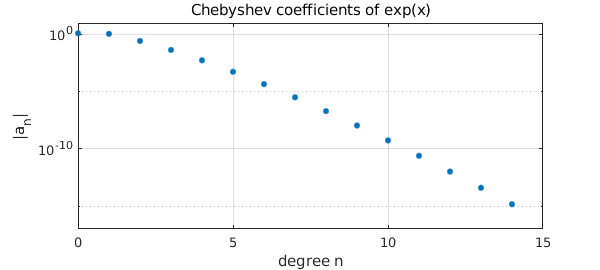
Here's a similar plot for a function that needs thousands of terms to be represented to 15 digits. (Can you explain why there are two lines of dots?)
plotcoeffs(exp(x)/(1+10000*x^2)), grid on
xlabel('degree n'), ylabel('|a_n|')
ylim([1e-18 1])
title('Chebyshev coefficients of exp(x)/(1+10000x^2)')
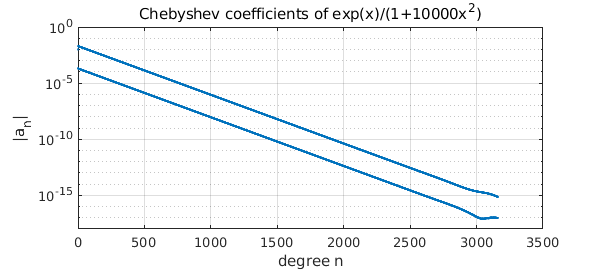
These methods will work for any function $f$ that's represented by a global polynomial, i.e., a chebfun consisting of one fun. What about Chebyshev coefficients for functions that are not smooth enough for such a representation? Here one can use the 'trunc' option in the Chebfun constructor. For example, suppose we are interested in the function
f = sign(x);
figure, plot(f,'k','jumpline','-'), ylim([-1.5 1.5])
title('sign(x)')
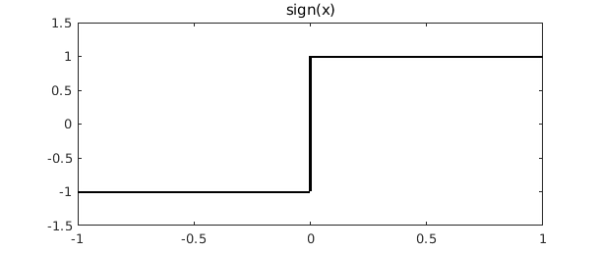
If we try to compute all the Chebyshev coefficients, we'll get an error. On the other hand we can compute the first ten of them like this:
p = chebfun(f,'trunc',10); a = chebcoeffs(p)
a = -0.000000000000000 1.273239544735162 -0.000000000000000 -0.424413181578388 0.000000000000000 0.254647908947032 -0.000000000000000 -0.181891363533594 -0.000000000000000 0.141471060526130
Here's the degree 9 polynomial obtained by adding up these first terms of the Chebyshev expansion:
hold on
plot(p,'m')
title('sign(x) and truncated Chebyshev series')
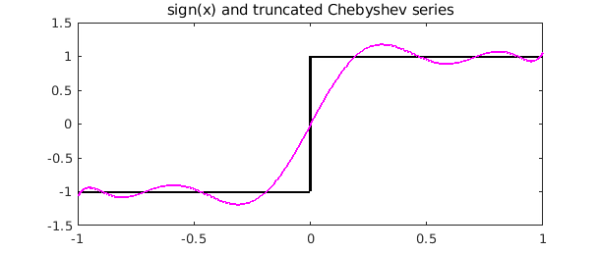
This is not the same as the degree 9 polynomial interpolant through 10 Chebyshev points, but they are close. See Chapters 4, 7, and 8 of [1].
pinterp = chebfun(f,10);
plot(pinterp)
title('Same, also with Chebyshev interpolant')
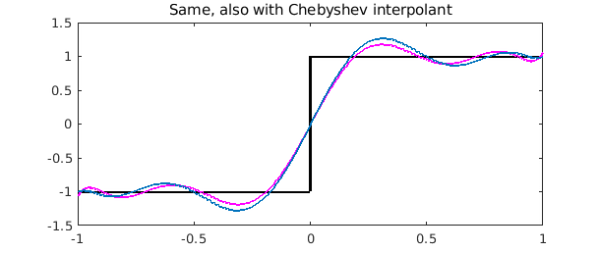
References
- L. N. Trefethen, Approximation Theory and Approximation Practice, SIAM, 2013.

